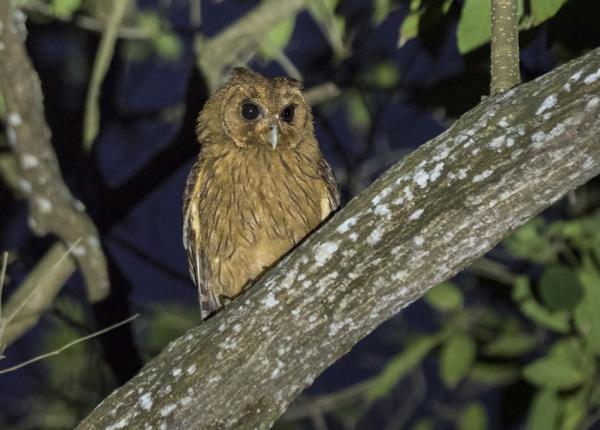Did You Know?
- The Jamaican Owl is in its very own genus, Pseudoscops
- Even though this owl is considered common in Jamaica, there is still a lot that needs to be learned about its biology and behavior.
How The Peregrine Fund is Helping
Though The Peregrine Fund does not work directly with Jamaican Owls, our efforts in scientific research, habitat conservation, education, and community development help conserve birds of prey around the world. We also supply literature to researchers from our avian research library, which helps scientists around the world gather and share important information on raptor conservation. Our work with the Neotropical Raptor Network helps conserve raptors by fostering collaboration and communication among raptor enthusiasts in the region. And, finally, our support of the Global Raptor Information Network gives raptor researchers tools to more efficiently conduct their own studies while contributing to a global program. It also provides citizen scientists a way to participate in raptor science and conservation.
Where They Live
As you might have guessed just by its name, the Jamaican Owl is found only in Jamaica, an island in the Caribbean. This beautiful owl prefers to spend its time in lowland habitats (usually below 600m) and can be seen hunting, perching or roosting in open wooded areas, along the edges of forests, even in gardens, parks or agricultural fields.
What They Do
The Jamaican Owl is a very striking owl. It has dark eyes, a bright rufous colored body marked with fine, black streaks along its breast, a facial disk edged with white and black feathers, and prominent ear tufts. When reading this description of a Jamaican Owl, perhaps you are wondering what a facial disk is and what ear tufts are.
The facial disk, a trait shared by most owls and even some diurnal birds of prey such as the Harpy Eagle and the Northern Harrier, is composed of feathers that form a circle around the bird’s face. The disk can be lifted or lowered at will. When the feathers of the facial disk are raised, they help direct sounds to the birds’ ears, which are located on the sides of its head. To find out how this works, cup your hands behind your ears and listen. You might notice that whatever you are listening to seems louder. The same thing happens when a bird lifts its facial disk. This helps the bird pinpoint prey using its hearing.
Ear tufts, in fact, aren't ears at all! Though the Jamaican Owl (and all birds) do have ears, they are small openings on the sides of their heads hidden by feathers. Ear tufts are just feathers that grow up on the side of the bird's head that resemble ears. In fact, they are used to aid in camouflage and even in species recognition.
This owl is nocturnal, meaning it is most active during night time hours.
Why They Need our Help
Although the Jamaican Owl is considered of Least Concern - meaning scientists aren't too worried about this species' populations at least for the near future - the truth is that there is still very much to learn about this owl. The fact that it isn't well known could mean that populations aren't doing as well as we think. What we do know is that a lot of forest habitat is being lost in Jamaica and this is no doubt having a harmful effect on these beautiful owls.
What They Eat
You might be surprised to learn that scientists still don't know very much about what Jamaican Owls prefer to eat. We know they eat a wide variety of prey including insects, such as beetles, small rodents, spiders, snakes and frogs. There is even one record of a Jamaican Owl feeding on a grackle - a type of bird! Scientists made this discovery by dissecting a Jamaican Owl's pellet. A pellet is a ball of fur and bones and other items the owls can't digest, which is later regurgitated from the owl's mouth.
Nest, Eggs and Young
Like most owls, Jamaican Owls don't build their own nests. Rather, they nest in tree cavities or in tree forks. They lay up to 2 eggs. Amazingly, this just about sums up the information scientists have about the nesting habits of this owl. There is still so much to learn! How quickly do the nestlings grow? At what age do they fly for the first time? Do both parents care for the young? This would be a wonderful species to study for anyone interested in owls!
Jamaican Owl and The World Center for Birds of Prey
The World Center for Birds of Prey offers fun ways to learn about birds of prey. Interactive activities, tours, interesting videos and a children's room with activities from coloring sheets to quizzes to costumes. Though Jamaican Owls aren't included among the education birds at the visitor center, we do have many other owl species at the center, providing visitors with a terrific opportunity to see owls up close and learn about the wonderful and interesting adaptations they have in order to survive in their respective habitats. There is also a touch table with owl feathers and other natural objects available for exploration.
References:
Olsen, P.D. and J. S. Marks (2020). Jamaican Owl (Pseudoscops grammicus), version 1.0. In Birds of the World (J. del Hoyo, A. Elliott, J. Sargatal, D. A. Christie, and E. de Juana, Editors). Cornell Lab of Ornithology, Ithaca, NY, USA. https://doi.org/10.2173/bow.jamowl1.01
Perrone Jr, M., 1981. Adaptive significance of ear tufts in owls. The Condor, 83(4), pp.383-384.









